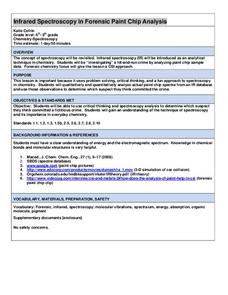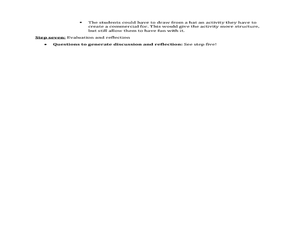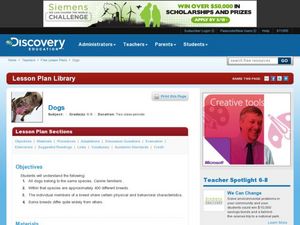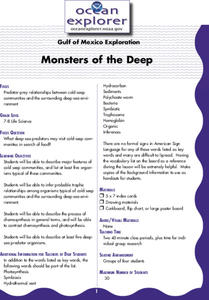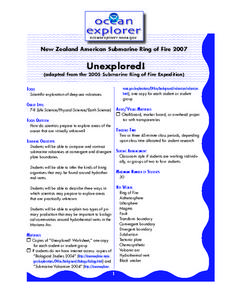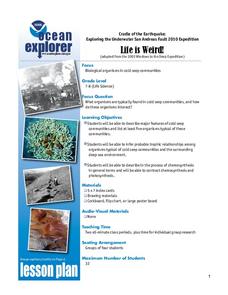Curated OER
Evaporation and Temperature Change
Students investigate the relationship between evaporation and temperature changes. In this evaporation and changes in temperature lesson, students measure the changes in temperature of different solutions on a cotton ball.
Curated OER
Energy Changes, Rates of Reactions, Nuclear Chemistry
In this energy changes, rates of reactions and nuclear chemistry learning exercise, students solve 14 problems to review concepts about endothermic and exothermic reactions, heat of combustion, heat of reactions, enthalpy, kinetic and...
Curated OER
Variables and Controls in an Investigation
Seventh graders identify variables and controls in a paper airplane investigation. In this scientific method lesson, 7th graders conduct an experiment to determine the variables that affect the flight of paper airplanes. They design an...
Curated OER
Internet Field Trip: Simple Machines
Students research simple machines. In this physics lesson, students participate in a WebQuest to gain knowledge about simple machines. WebQuest activities and worksheets are included in this lesson.
Curated OER
Reduce Reuse Recycle
Students discover methods that can save the planet by recycling. For this sustainable planet lesson, students read The Berenstein Bears Don't Pollute Anymore, and practice memorizing the 3 R's. Students write commitment letters...
Curated OER
Infrared Spectroscopy in Forensic Chip Analysis
Students analyze spectrums as related to forensics. In this chemistry lesson, students define spectroscopy and discuss its use in chemistry. They discuss how the Forensic Paint Chip is used to help solve crimes.
Curated OER
Ben Franklin's Inventions
Students discover the life of Benjamin Franklin by studying his inventions. In this biography lesson, students identify the inventions of Benjamin Franklin and their impact on society today. Students create a commercial in an attempt...
Curated OER
Predator vs. Prey
Fifth graders participate in a game to become familiar with predators and preys. In this predator vs. prey lesson, 5th graders ascertain whether a photo shows an organism as a predator or a prey. Students read Killer Creatures. Students...
Curated OER
Dogs- Canine Familiaris
Students research dog species and breeds. In this dog lesson, students discuss breed of dogs, their personal experiences, and complete a Venn Diagram comparing breeds. Students use the research to analyze television shows or movies which...
Curated OER
Dibble Pond Ecosystem
Students collect specimen and analyze it. In this biology activity, students analyze and evaluate the diversity found in specific environment. They use the correct terminology as they do their write up for the experiment.
Curated OER
What is an Ahupua'a?
Students research ahupua'a ecosystems. For this ahupua'a lesson, students explore how land is subdivided in Hawaii and the effect on the ecosystem. Resources are provided.
Curated OER
HIV and AIDS: Understanding Risk Behaviors
Eighth graders research human sexuality by completing a sexual health worksheet. In this HIV lesson plan, 8th graders define AIDS and list the ways it can be transmitted from human to human. Students assess their own risk and complete...
Curated OER
A Star is Born
Students research the life cycle of a star. In this astronomy instructional activity, students work in groups to research on stage in stellar evolution and report back to the class their findings. They will discuss as a class the order...
Curated OER
The Five Senses
Study various objects and help kindergarteners use their five senses to classify the objects. They are presented with various objects and then use their five senses to sort and classify the objects. Then they use a Visual Ranking Tool to...
Curated OER
Life of an Island: From Mountain to Atoll
Students research the evolution of a volcanic island from origin to erosion. They determine the relative ages of the Northwestern Hawaiian Islands given their position in the archipelago.
Curated OER
Monsters of the Deep
Students describe major features of cold seep communities, and list at least five organisms typical of these communities. They infer probable trophic relationships among organisms typical of cold-seep communities.
Curated OER
It's a Gas! Or is it?
Young scholars describe the effects of temperature and pressure on solubility of gases and other materials. In this investigative lesson students read an article and answer questions about it.
Curated OER
Who Has the Light?
Students study ways in which the ability to produce light may be useful to deep-sea organisms. In groups, they research and present to the rest of the class, how a specific organism is able to produce bioluminescence.
Curated OER
All Steamed Up
Students examine the energy conversions and simple machines are involved in the operation of a steam engine. They make a replica of a small steam engine.
Curated OER
Unexplored!
Students explore volcanoes. In this deep sea volcano activity students complete a worksheet and various activities.
Curated OER
Monsters of the Deep
Students describe major features of cold seep communities and list the organisms that are typical in these communities. For this deep sea environment lesson students work in groups and research their given cold seep group.
Curated OER
Life is Weird
Young scholars describe features of cold seep communities and investigate five organisms that live there. In this biological organisms lesson students research a given species and give an oral presentation on their results.
Curated OER
Life is Weird
Students study the organisms that are found in cold seeps and see how they interact with each-other. In this biological organism lesson students describe the major features of cold seeps and the process of chemosynthesis.
Curated OER
Life is Weird
Learners describe features of cold seep communities and list organisms that can be found in these communities. In this exploratory lesson plan students complete an activity and describe the process of chemosynthesis.







